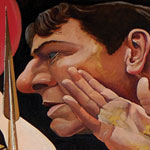
 (September 21, 1849 - March 26, 1905)
(September 21, 1849 - March 26, 1905)
Not far from the Taj Mahal in India, where his father was a surveyor for the British East India Company, Herbert Arthur Chamberlayne Blyth was born in 1849. A few years later, he was sent to England, where he studied law and won the top national amateur boxing championship, the Marquis of Queensberry Cup, in 1872. Instead of pursuing his law career, Herbert Blythe began acting in London, where he took the stage name Maurice Barrymore to save his family from the embarrassment of having their name associated with the theatre. Ironically, the name Barrymore has become one of the most well-known in American theatre.
Soon thereafter, the sophisticated dandy made his Boston debut in Under the Gaslight and then, on Broadway, as the handsome lover in Pique. Within a year, Barrymore had married his costar, Georgiana Drew; the couple had three children, Lionel, Ethel, and John, who all joined their parents in theatrical careers. An immediate Broadway success, Barrymore starred with many of the most important, Toledo-bound actors of the time, including Edwin Booth, Helen Modjeska (as her Orlando and Romeo), Mrs. Fiske, Lily Langtry, and Lillian Russell.
In 1879, Barrymore and a troupe of New York actors were on tour in Texas. Midway through their successful run of Sardou's political-intrigue drama Diplomacy, he and his fellow company-member Ben Porter found themselves in a stand-off with Big Jim Currie, a drunken trouble-maker. After insulting Porter's fiancé, Currie shot both unarmed men, killing Porter and badly wounding Barrymore. Despite the eye witnesses' reports and the widespread publicity about the crime, the unrepentant Big Jim Currie was twice found not guilty - thanks in large part to the legal wranglings of his brother, the mayor of Shreveport, Louisiana. Outraged, Barrymore retorted that "This reminds me of our performances in England. We commence with a tragedy and end with a farce." For the rest of his life, he refused to return to Texas.
After Georgiana Drew Barrymore died in 1893, Maurice Barrymore married Mamie Floyd. Despite erratic, uncontrollable ravings that signaled the late stages of syphilis, he continued his illustrious life on the stage up until his death in 1905. The Barrymore legacy, however, continued through the lives of all three of his children, several grandchildren, and his great-granddaughter, Drew Barrymore.
Resources
Kotsilibas-Davis, James. Great Times, Good Times: The Odyssey of Maurice Barrymore. Garden City, NY: Doubleday, 1977.
Covering over 500 pages, including sixteen pages of photographs and an extensive bibliography, this is Barrymore's definitive biography.
"Maurice Barrymore." IBDb. http://www.ibdb.com/person.php?id=31144. 7 July 2008.
"Maurice Barrymore." Wikipedia. http://en.wikipedia.org/wiki/Maurice_Barrymore.
New York Public Library. "Maurice Barrymore." NYPL Digital Gallery. 29 Feb. 2008. 7 July 2008. http://digitalgallery.nypl.org/nypldigital/dgkeysearchresult.cfm?parent_id= 141540&word=.
Hosted by the New York Public Library, this gallery contains several dozen photographs of Barrymore in dashing theatrical costume.
Shulman, Terry. "Maurice Barrymore: An English Actor in the Wild West." HistoryNet.com. Originally published as "Bullets for Barrymore" in Wild West 10:6 (April 1998). 7 July 2008. http://www.historynet.com/maurice-barrymore-an-english-actor-in-the-wild-west.htm.
This article tells the store of Barrymore's near-fatal Texas encounter and the two trials whose juries found Big Jim Currie not guilty.